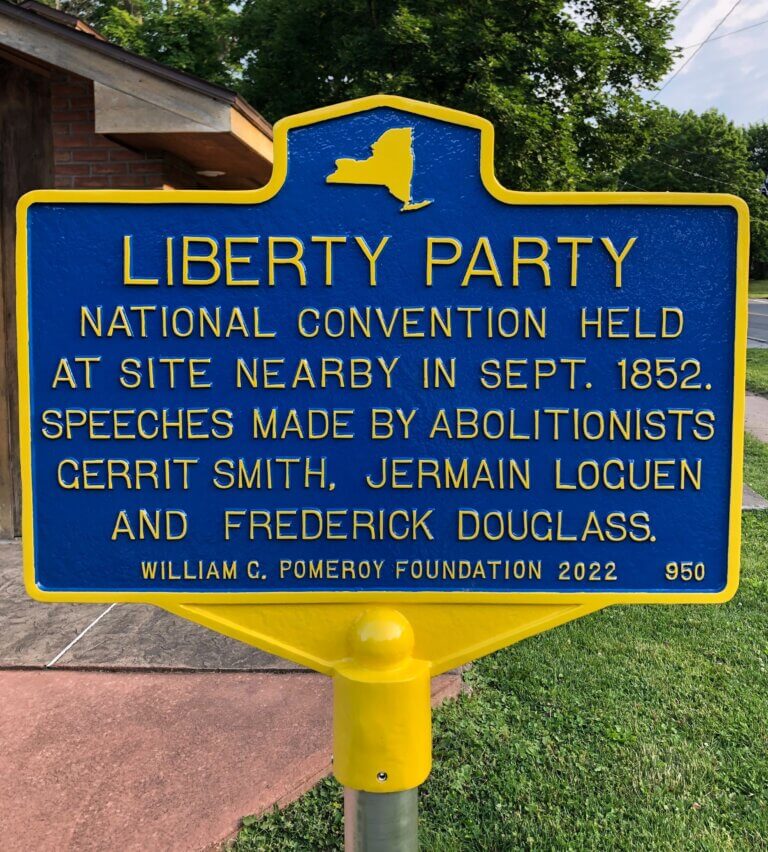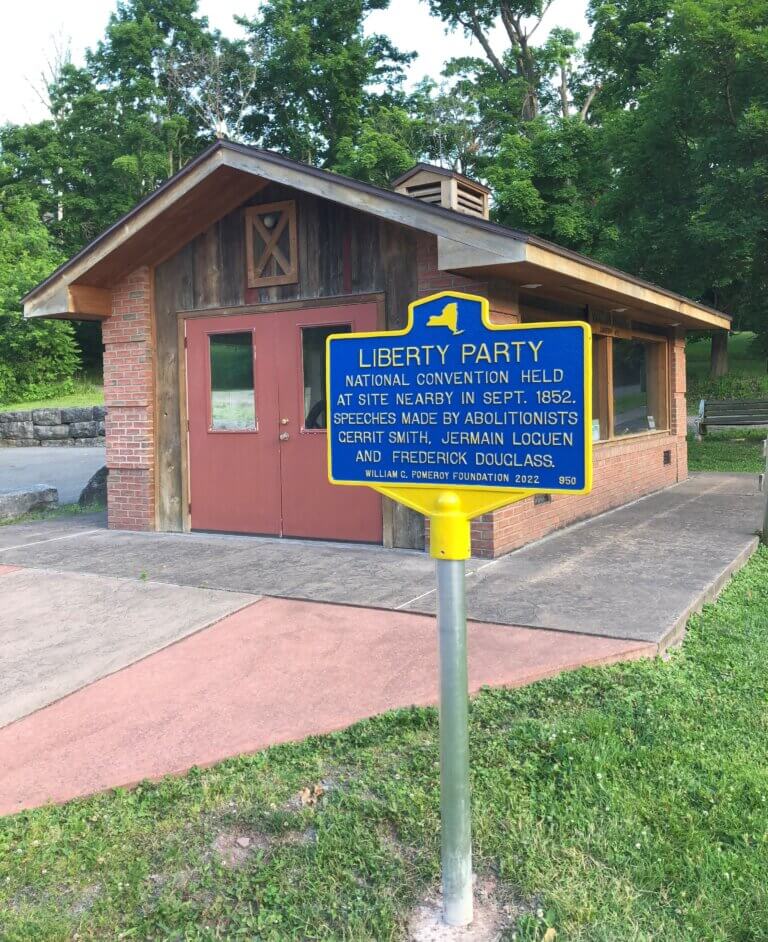LIBERTY PARTY
- Program
- Subject
- Location
- Lat/Long
- Grant Recipient
-
NYS Historic
-
Event, People, Site
- 230 S Peterboro St, Canastota, NY 13032, USA
- 43.076863637886, -75.751724991118
-
Town of Lenox
LIBERTY PARTY
Inscription
LIBERTY PARTYNATIONAL CONVENTION HELD
AT SITE NEARBY IN SEPT. 1852.
SPEECHES MADE BY ABOLITIONISTS
GERRIT SMITH, JERMAIN LOGUEN
AND FREDERICK DOUGLASS.
WILLIAM G. POMEROY FOUNDATION 2022
In September 1852, the Liberty Party held a national convention in the Dutch Reformed Church on Peterboro Street in Canastota, Madison County, New York. The Liberty Party was an abolitionist third party formed in New York State in 1840. It developed out of divisions within organized abolitionist groups over the constitutionality of slavery. Unlike the American Anti-Slavery Society, which held that the United States Constitution was inherently pro-slavery, Liberty Party leaders believed that the Constitution could be interpreted as an anti-slavery document and that they could work for the abolition of slavery within the established political structure.
On the first day of the 1852 Liberty Party national convention in Canastota, party leader and staunch abolitionist, Gerrit Smith delivered the minority report, recommending that the Liberty Party not make its own nominations for president and vice-president for the upcoming election, but instead support the Free Soil Party candidates, while still retaining the Liberty Party organization. The Free Soil Party had been established in 1848 in opposition to the expansion of slavery. In August 1852, the Free Soil Party had nominated New Hampshire Senator John P. Hale for president and George W. Julian for vice-president. The Liberty Party convention’s majority report was given by New York abolitionist William Goodell. In opposition of Smith, Goodell’s report made its own recommendations for president and vice-presidential candidates and did not support the candidates nominated by the Free Soil Party.
Rev. Jermain W. Loguen, a Syracuse abolitionist and Liberty Party leader, was in attendance at the 1852 Liberty Party convention in Canastota. Loguen had been born into slavery in Tennessee, escaping to Canada as a young man. He eventually returned to the United States, settling in Central New York. Loguen dedicated his life to the abolitionist cause, aiding those escaping slavery via the Underground Railroad. Loguen served as a vice-president of the 1852 Liberty Party convention in Canastota. According to the September 2, 1852 morning edition of the New York Herald, his address to the convention included an explanation of how as a fugitive slave, his position was different from others, noting that “he did not believe in running away – he believed more in fighting than running” and that “he would rather purchase his freedom with his blood than with his money.”
Throughout the second day of the convention, the majority and minority reports were debated and discussed. Noted abolitionist, Frederick Douglass addressed the convention both days in support of Smith’s minority report that would have the Liberty Party vote for the Free Soil candidates, while still retaining the Liberty Party organization. During the afternoon session, Goodell’s majority report was rejected and Smith’s minority report carried. A committee was appointed to confer with the Free Soil candidates, Hale and Julian, as to their views on the legality of slavery. The convention adjourned to meet at Syracuse later that month. Between the Canastota and Syracuse conventions, the September 25, 1852 edition of the Anti-Slavery Bugle, reported that Smith had reversed the Liberty Party’s decision to support the Free Soil candidates. At the Syracuse convention held on September 30 and October 1, the Liberty Party nominated William Goodell for president and S.M. Bell of Virginia for vice-president.
Liberty Party numbers began to dwindle through the 1850s, with members joining the Free Soil Party and the Republican Party upon its 1854 formation. However, the Liberty Party is noted in contemporary newspapers as holding nominating conventions through at least 1860 (“New York Liberty Party,” Anti-Slavery Bugle, September 29, 1855, 3; “Liberty Party Nominations,” Douglass’ Monthly, October 1860, 339-40).


